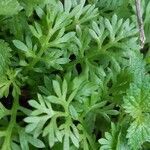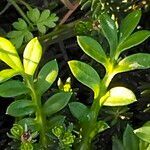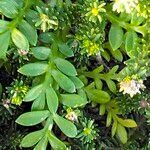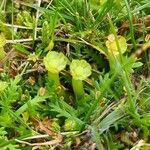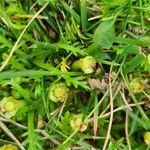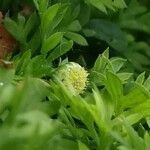Annual herb up to c. 20 cm tall, often much shorter, well branched from the base, stems decumbent, thinly villous, leafy. Leaves up to 6 x 2 cm, roughly oblong in outline, at least the lower ones bipinnatisect, the lobes linear-lanceolate, acute, often glabrous above, thinly villous below, base dilated and half-clasping, sometimes toothed. Heads heterogamous, depressed-globose, c. 5 mm across, solitary on nude axillary and terminal peduncles up to c. 8 cm long, much exceeding the leaves, hairs below the heads appressed-ascending. Involucral bracts more or less uniseriate, margins broad, scarious, glabrous, midline with sparse appressed hairs. Receptacle tubercled from persistent pedicels, those of the outer, female, flowers in c. 3 series, long, of the hermaphrodite flowers very short. Corollas of female flowers much reduced, of hermaphrodite flowers whitish, nondescript. Achenes of female flowers c. 1.5 mm long, compressed, broadly winged, both faces alike, glandular, of hermaphrodite flowers c. 1 mm long, flattened on inner face, convex on outer, margined but not winged, glandular or not, viscid.
Ascending to erect, slender annual up to 10-(15) cm tall. Stems terete, much-branched from base and above, sparsely to densely clothed in long hairs, up to 20-(40) cm long, not rooting at nodes. Lvs membranous, sparsely to moderately hairy, spathulate, deeply 1-2-pinnatisect, (5)-10-35-(50) mm long; lowermost lvs opposite, petiolate, amplexicaul; lvs above becoming alternate, smaller, apetiolate, and 1-pinnatisect. Involucral bracts in 2 rows, glabrous or with a few scattered hairs, 2-3 mm long. Capitula solitary, pale yellow, 3-5-(6) mm diam.; peduncle sparsely to densely clothed in antrorse hairs, very slightly expanded at apex but solid, (1)-3-6 cm long, 0.5-1 mm diam.; ♀ florets in 2-3 rows, pedicellate, lacking any corolla; ☿ florets (15)-30-40-(50), subsessile, with tubular corolla. Achenes of ♀ florets flattened, 1.2-1.5 × 0.7-1 mm, hairy on both surfaces; lateral angles with thin, glabrous, entire, marginal wings. Achenes of ☿ florets flattened on inner surface, c. 0.9-1.1 × 0.4-0.5 mm, glabrous; lateral angles thinly ribbed.
Annuals or short-lived perennials to c. 10 cm high. Stems moderately hairy, with hairs antrorse-divergent to spreading. Leaves to c. 4 cm long, 1-or 2-pinnatisect, moderately hairy. Capitulum 2–8 mm diam.; peduncle mostly 2–8 cm long, c. 0.1–0.6 mm wide (pressed specimens), hardly obconical at maturity, moderately hirsute at anthesis, with hairs antrorse, appressed to divergent; involucral bracts 5–20, oblong to oblong-ovate, 1.5–3 mm long, rounded apically. Marginal florets numerous, multi-seriate, with pedicels 0.5–1 mm long. Disc florets bisexual, 15–25, with pedicels hardly longer than wide; corolla c. 0.5 mm long; limb pale yellow to white. Achenes of marginal florets c. 1–1.5 mm long; faces oblong, minutely papillose; wings fleshy, slightly narrower than face. Achenes of disc florets c. 1 mm long; faces oblong, glabrous. [See also Green (1994).]
Annual herb, up to 200 mm high; erect or decumbent. Leaves alternate, petiolate; blade oblong in outline, bipinnatisect, segments linear, acute, margins entire or sometimes dentate, thinly pubescent. Heads disciform, solitary, terminal, pedunculate; peduncles much exceeding leaves, hairs below heads appressed-ascending. Involucral bracts 1-or 2-seriate, elliptic with scarious margins. Receptacle epaleate. Flowers: outer female florets stalked, 2-or 3-seriate, corolla absent or much reduced; disc florets stalked, 4-lobed; whitish; Oct. Fruit with cypsela of outer female florets dorsiventrally flattened, winged; of disc florets dorsiventrally flattened, margined but not winged. Pappus absent.
Annual, erect or decumbent herb, up to 200 mm high. Leaves alternate, bipinnatisect, glabrous above, thinly villous below, base half-clasping. Capitula disciform, solitary, terminal and axillary, pedunculate; peduncles much exceeding leaves, hairs below capitula appressed-ascending; involucral bracts ± uniseriate, margins scarious, glabrous but with some hairs along midline. Outer female florets in ± 3 series, corolla wanting. Disc florets bisexual, corolla tubular below, globose-campanulate above, 4-lobed, whitish. Flowering time July-Oct. Pappus absent. Cypselae of female florets compressed, winged, of disc florets margined but not winged.
Annuals, 2–10(–25+) cm. Stems branched ± throughout, ± strigillose to villous, glabrescent. Leaves petiolate or sessile; blades obovate to spatulate, 2–3-pinnately lobed (ultimate lobes narrowly spatulate to linear), (1–)2–3(–6) cm. Involucres 3–4(–6) mm diam. Phyllaries 13–22+ in 2–3 series, subequal (apices brown). Ray florets 0 (peripheral pistillate florets 8–80+ in 1–3+ series; corollas 0). Disc corollas ochroleucous to pale yellow, 0.5–0.8 mm. Cypselae: outer stalked, 1–1.2 mm, ± winged, faces ± papillate; inner sessile, 0.8–1 mm, not winged, not papillate. 2n = 36, 40.
Slender weak diffusely branched annual or winter annual up to ± 10 cm. tall, us. bearing lax spreading hairs. Lvs ± 12-30 mm. long, membr., ± oblong, pinnatisect to bipinnatisect; segs linear, entire, acute, sts apiculate. Scapes very slender; capitula ± 2.5-5 mm. diam.; phyll. in c. 2 series, narrow-oblong, obtuse. Florets white; ♀ ∞, in c. 3 series, on very slender pedicels; disk-florets perfect, very few. Achenes obovoid, glandular, wings thick.
Prostrate or ascending annual, up to 250 mm long. Leaves bipinnatifid, oblanceolate in outline, thinly pubescent. Flowerheads disciform, solitary, on long peduncles; outer florets female, in 3 series, corolla absent; disc florets bisexual, white or yellow-green. Cypselas of female florets elliptic, winged, of disc florets obovoid, not winged; pappus absent.
Annual, erect or decumbent herb, up to 200 mm tall. Peduncles much exceeding leaves, hairs below heads appressed-ascending. Female flowers in ± 3 series. Corolla wanting or much reduced in outer, female flowers. Flowers whitish; October, March and June.
